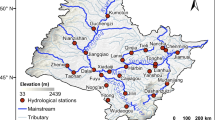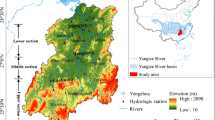Abstract
Water resources in the Yangtze River, the longest river in China, are of great importance for the water security of China. In this study, 146 years (1865–2010) of streamflow data were used to investigate the changes in streamflow of the Yangtze River. The Mann-Kendall test and wavelet coherence analysis were used to test the change points in annual streamflow. The streamflow data, combined with the meteorological dataset of the Climatic Research Unit (CRU) from 1901 to 2010, showed that the Yangtze River streamflow changes occurred in four major periods over the past century: 1901–1930, 1931–1960, 1961–1990, and 1991–2010. The average annual streamflow for the four periods was 497.26, 499.11, 476.25, and 471.93 mm, respectively. The period from 1901 to 1930 was considered the baseline period for estimating the streamflow changes during the other three periods. We found that the streamflow increase during 1931–1960 was mainly influenced by climatic variation, while the streamflow decrease during 1961–1990 was mainly attributed to human activities because of tremendous population growth and rapid economic development. During the period 1991–2010, both climatic variation and human activities led to a decrease in streamflow, and human activities were still the main driving factor for the streamflow decrease. However, the contribution proportion of human activities to the streamflow decrease during 1991–2010 was much smaller than that during 1961–1990. The estimation results indicated that human activities have become the dominant driving factors of the streamflow changes in the Yangtze River Basin since 1961. Human activities, such as booming socio-economic development and fast population growth, have brought new challenges for water resources management in the Yangtze River Basin.









Similar content being viewed by others
References
Allen RG, Pereira LS, Raes D, Smith M (1998) Crop evapotranspiration-Guidelines for computing crop water requirements-FAO Irrigation and drainage paper 56. FAO Rome 300:6541
Andreo B, Jiménez P, Durán J, Carrasco F, Vadillo I, Mangin A (2006) Climatic and hydrological variations during the last 117–166 years in the south of the Iberian Peninsula, from spectral and correlation analyses and continuous wavelet analyses. J Hydrol 324(1):24–39
Arora VK (2002) The use of the aridity index to assess climate change effect on annual runoff. J Hydrol 265(1):164–177
Budyko MI (1963) Evaporation under natural conditions, Israel Program for Scientific Translations, available from the Office of Technical Services. US Dept. of Commerce, Washington
Carey SK, Tetzlaff D, Buttle J, Laudon H, McDonnell J, McGuire K, Seibert J, Soulsby C, Shanley J (2013) Use of color maps and wavelet coherence to discern seasonal and inter annual climate influences on streamflow variability in northern catchments. Water Resour Res. doi:10.1002/wrcr.20469
Chen L (2012) Fully implement the most strict water resources management system to protect the stable and rapid development of economic and social. China Water Res 10:1–6 (in Chinese)
Dai Z, Du J, Li J, Li W, Chen J (2008) Runoff characteristics of the Changjiang River during 2006: effect of extreme drought and the impounding of the Three Gorges Dam. Geophys Res Lett 35(7). doi: 10.1029/2008GL033456
Dooge J, Bruen M, Parmentier B (1999) A simple model for estimating the sensitivity of runoff to long-term changes in precipitation without a change in vegetation. Adv Water Resour 23(2):153–163
Duan X, Yu X (2002) Analysis and assessment of the sustainable development in Changjiang River valley. China Popul Resour Environ 12(2):75–80 (in Chinese)
Frans C, Istanbulluoglu E, Mishra V, Munoz-Arriola F, Lettenmaier DP (2013) Are climatic or land cover changes the dominant cause of runoff trends in the Upper Mississippi River Basin? Geophys Res Lett. doi:10.1002/grl.50262
Fu B (1981) On the calculation of the evaporation from land surface. Sci Atmos Sin 5(1):23–31 (in Chinese)
Grinsted A, Moore JC, Jevrejeva S (2004) Application of the cross wavelet transform and wavelet coherence to geophysical time series. Nonlinear Proc Geophys 11(5/6):561–566
Jiang T, Chen YD, C-y X, Chen X, Chen X, Singh VP (2007) Comparison of hydrological impacts of climate change simulated by six hydrological models in the Dongjiang Basin, South China. J Hydrol 336(3):316–333
Jones P, Lister D, Osborn T, Harpham C, Salmon M, Morice C (2012) Hemispheric and large-scale land-surface air temperature variations: an extensive revision and an update to 2010. J Geophys Res. doi:10.1029/2011JD017139
Kendall M (1975) Rank correlation measures. Charles Griffin, London, 202
Krause P, Boyle D, Bäse F (2005) Comparison of different efficiency criteria for hydrological model assessment. Adv Geosci 5(5):89–97
Labat D, Ababou R, Mangin A (2000) Rainfall–runoff relations for karstic springs. Part II: continuous wavelet and discrete orthogonal multiresolution analyses. J Hydrol 238(3):149–178
Labat D, Goddéris Y, Probst JL, Guyot JL (2004) Evidence for global runoff increase related to climate warming. Adv Water Resour 27(6):631–642
Liu X, Zheng H, Zhang M, Liu C (2011) Identification of dominant climate factor for pan evaporation trend in the Tibetan Plateau. J Geogr Sci 21(4):594–608
Liu X, Liu C, Luo Y, Zhang M, Xia J (2012) Dramatic decrease in streamflow from the headwater source in the central route of China’s water diversion project: climatic variation or human influence? J Geophys Res 117, D06113. doi:10.1029/2011JD016879
Ma H, Yang D, Tan SK, Gao B, Hu Q (2010) Impact of climate variability and human activity on streamflow decrease in the Miyun Reservoir catchment. J Hydrol 389(3):317–324
Mann HB (1945) Nonparametric tests against trend. Econometrica. J Econ Soc 13:245–259
Marengo JA, Tomasella J, Uvo CR (1998) Trends in streamflow and rainfall in tropical South America: Amazonia, eastern Brazil, and northwestern Peru. J Geophys Res 103(D2):1775–1783
McVicar TR, Roderick ML (2010) Atmospheric science: winds of change. Nat Geosci 3(11):747–748
Milly PC, Dunne K, Vecchia AV (2005) Global pattern of trends in streamflow and water availability in a changing climate. Nature 438(7066):347–350
Milly P, Julio B, Malin F, Robert M, Zbigniew W, Dennis P, Ronald J (2008) Stationarity is dead: Whither Water Management? Science 319(5863):573–574
Nash J, Sutcliffe J (1970) River flow forecasting through conceptual models part I—a discussion of principles. J Hydrol 10(3):282–290
Partal T, Kahya E (2006) Trend analysis in Turkish precipitation data. Hydrol Process 20(9):2011–2026
Piao S, Friedlingstein P, Ciais P, de Noblet-Ducoudré N, Labat D, Zaehle S (2007) Changes in climate and land use have a larger direct impact than rising CO2 on global river runoff trends. Proc Natl Acad Sci 104(39):15242–15247
Qin D, Zhang K, Niu W (2002) Population, resources, environment and sustainable development in China. Xinhua Publishing House, China (in Chinese)
Smadi MM, Zghoul A (2006) A sudden change in rainfall characteristics in Amman, Jordan during the mid 1950s. Am J Env Sci 2(3):84–91
Torrence C, Compo GP (1998) A practical guide to wavelet analysis. Bull Am Meteorol Soc 79(1):61–78
Vautard R, Cattiaux J, Yiou P, Thépaut J-N, Ciais P (2010) Northern Hemisphere atmospheric stilling partly attributed to an increase in surface roughness. Nat Geosci 3(11):756–761
Wu C, Dong Z (2010) Economic history of People's Republic of China, Social Sciences Academic Press (in Chinese)
Ye X, Zhang Q, Liu J, Li X, C-y X (2013) Distinguishing the relative impacts of climate change and human activities on variation of streamflow in the Poyang Lake catchment, China. J Hydrol 494:83–95
Zhang Q, Liu C, Xu C-y XY, Jiang T (2006) Observed trends of annual maximum water level and streamflow during past 130 years in the Yangtze River basin, China. J Hydrol 324(1):255–265
Zhang Q, C-y X, Jiang T, Wu Y (2007) Possible influence of ENSO on annual maximum streamflow of the Yangtze River, China. J Hydrol 333(2):265–274
Zhang Z, Chen X, Xu C-Y, Yuan L, Yong B, Yan S (2011) Evaluating the non-stationary relationship between precipitation and streamflow in nine major basins of China during the past 50 years. J Hydrol 409(1):81–93
Zhang D, Liu C, Liu X (2012a) Change in global radiation and its impacts on the water cycle in the Yangtze River basin from 1961 to 2010. Water Int 37(5):598–610
Zhang Q, Li L, Wang YG, Werner AD, Xin P, Jiang T, Barry DA (2012b) Has the Three-Gorges Dam made the Poyang Lake wetlands wetter and drier? Geophys Res Lett. doi:10.1029/2012GL053431
Zhang D, Liu X, Liu C, Bai P (2013) Responses of runoff to climatic variation and human activities in the Fenhe River, China. Stoch Env Res Risk A 27:1293–1301
Zheng H, Zhang L, Zhu R, Liu C, Sato Y, Fukushima Y (2009) Responses of streamflow to climate and land surface change in the headwaters of the Yellow River Basin. Water Resour Res 45(7):W00A19
Zong Y, Chen X (2000) The 1998 flood on the Yangtze, China. Nat Hazards 22(2):165–184
Acknowledgments
This research was supported by the National Basic Research Program of China (2012CB417003), Sciences Foundation of Nanjing Institute of Geography and Limnology (NIGLAS2012135001) and National Natural Science Foundation of China (41371062).
Author information
Authors and Affiliations
Corresponding author
Rights and permissions
About this article
Cite this article
Zhang, D., Hong, H., Zhang, Q. et al. Attribution of the changes in annual streamflow in the Yangtze River Basin over the past 146 years. Theor Appl Climatol 119, 323–332 (2015). https://doi.org/10.1007/s00704-014-1121-3
Received:
Accepted:
Published:
Issue Date:
DOI: https://doi.org/10.1007/s00704-014-1121-3




